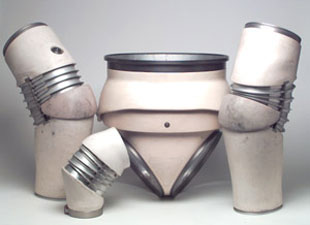
Space History News
space history and collectibles feature articles
Messages
discussion forums about space history and collecting
Sightings
calendar of worldwide astronaut appearances
buySPACE
marketplace for space artifacts, toys and memorabilia
Resources
collecting guides and selected space history documents
Websites
related space memorabilia and history websites
|
- The Editor's Collection -
Artifacts
space flown equipment and ground support hardware
Autographs
who's who in space: the first 25 years of space exploration
Books
galleys, drafts, and advanced reading copies
Medallions
flown coins and those minted with flown metal
Philatelics
first day ceremony programs and flown stamps
|
|

|

Image Gallery:
Highlights of the Fall 1999 Superior Galleries' Space Memorabilia Auction

0357. RX-3 Space Suit Components
During the early days of the Apollo Lunar Program, on eof the most difficult developments was the space suit the astronauts would wear on the moon. Many different companies and numerous designs were submitted to NASA for evaluation. Litton Industries, Inc. developed a series of "RX" suits that greatly expanded the design envelope for pressure suits. Litton Systems, Inc. developed a series of "RX" suits that used a "hard shell" design. These suits proved to be as flexible pressurized as they were unpressurized, and proved more reliable and flexible than soft suits. The negative was that the "RX" hard suit design was also heavier and proved too difficult to fold up for storage in a cramped Apollo spacecraft. The legacy of the Litton hard suits remain as the Shuttle EVA space suit uses a hard upper torso design, and several hard suits that are nearly identical to the "RX" series are being tested by NASA for use onboard the International Space Station. Five different "RX" hard suits were developed, with usually only one copy of each model built for testing, making the suit not only one of the most famous of the Apollo prototypes, but one of the rarest. The components offered here consist of the lower torso assembly, both lower leg units and the left elbow. These are spare parts from the RX-3 suit built in 1966. This version weighed 62 lbs. in total, but was a major 18 lb. reduction in weight accomplished by using magnesium and magnesium-lithium alloys in the rotary seals and shell elements. This suit also had a versatile sizing system. The limb and torso elements could be made available in a wide variety of standard sizes. Each piece consists of both hard and soft (joint) elements. This is a unique opportunity to acquire an important development step in spacesuit design and space history.
$7500-10000
back to Space Memorabilia Auction Gallery

© 1999-2002 collectSPACE.com All rights reserved.
Questions? E-mail contact@collectspace.com

|
|

|
|
